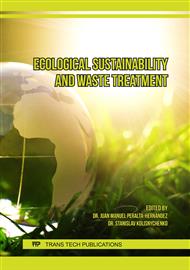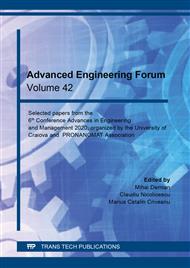p.122
p.128
p.137
p.143
p.151
p.159
p.167
p.176
p.184
Sustainable Remediation of Soils Contaminated with Petroleum Products
Abstract:
In nature, it acts, simultaneously or successively, synergistically or antagonistically, on small or larger spaces, for a long or very short time, numerous natural or artificial processes that pollute, leading to the alteration of the quality of the environment. The basic activity carried out within the oil scaffolding consists in the extraction of crude oil and gases from the deposits in their exploitation, their collection, separation of phases (crude oil, reservoir water, gas), crude oil treatment, storage and sending to users. Contamination of the field related to drilling-extraction wells with crude oil, heavy petroleum products, salt water, various chemicals, etc. has a random character, but with undesirable implications on soil, surface water and / or groundwater, depending on the nature of the pollutant, its quantity and area of spread Pollution sources in the oil industry, both systematic and accidental, have a greater or lesser spread, depending on the size of the field, the type and composition of the extracted fluids, the extraction technology used, the age of oil exploitation in the area, relief and hydrographic network. Having available the data provided by the pollution diagnosis, it is possible to assess the risk that the investigated pollution represents for the people on the site and for the natural environment. If it turns out that the risk is significant, then the decision is made to switch to depollution works. The choice of an appropriate depollution path is made on the basis of relevant technical and economic criteria, which is a feasibility study. The proposed depollution technology must be the most appropriate for the case at hand and, at the same time, be available on the technology market. The most important part of the paper is dedicated to presenting the results of an experimental study on the depollution of soils contaminated with liquid petroleum products by sparging technologies, in order to ensure a sustainable remedy. The results of the soil analysis used in the experimental determination are presented, as well as the physic - chemical characteristics of the main soil pollutants. In the experimental part, laboratory decontamination of systems consisting of polluted soils was performed at the laboratory level, using air as a depollution agent. The processing of the data obtained from the experimental determinations allowed obtaining qualitative and quantitative information related to the decontamination speed depending on the nature of the soil, the nature and concentration of the pollutant and the temperature of the decontamination air. Estimating the cost places this technology at a low level compared to thermal technologies and slightly higher than microbiological technologies.
Info:
Periodical:
Pages:
151-158
Citation:
Online since:
September 2021
Authors:
Keywords:
Price:
Сopyright:
© 2021 Trans Tech Publications Ltd. All Rights Reserved
Share:
Citation:



